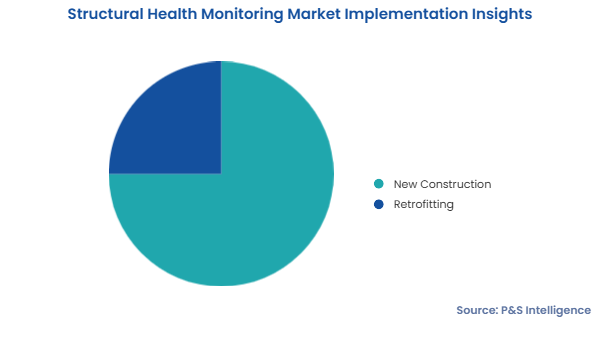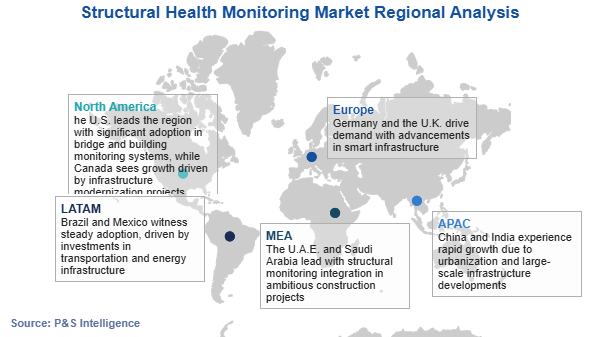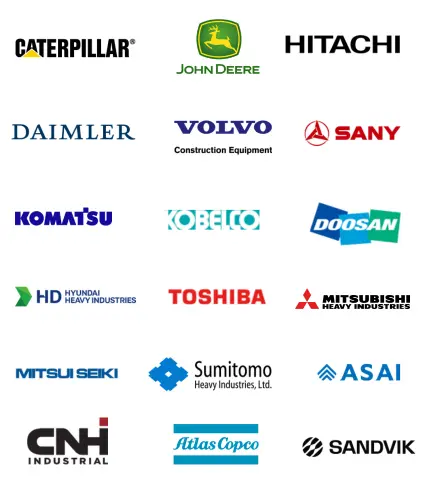Structural Health Monitoring Industry Insights
Offering Insights
- The hardware category will hold the largest market share, of 55%, in 2024. A large number of expensive sensors and transmitters are used for monitoring a variety of physical parameters.
- The software category will grow at the highest CAGR, of 12%, during the forecast period.
- This is due to the developments in AI, ML, and cloud computing, which enable predictive maintenance and improves decision-making.
- Moreover, the integration of cloud computing technologies into SHM systems is facilitating the gathering, storage, sharing, and analysis of the significant volume of data gathered by sensors.
The offerings included in this report are:
- Hardware (Largest Category)
- Software (Fastest-Growing Category)
- Services
Technology Insights
- The wired category will hold the larger market share, of 70%, in 2024.
- This is because a wired system offers reliable, uninterrupted connections essential for the long-term monitoring of critical structures, such as bridges, tunnels, and dams.
- The wireless category will be the faster-growing category, with a CAGR of 11.5%, during the forecast period.
- This is due to the integration of IoT in the wireless systems, which allows real-time monitoring data from infrastructure.
- Additionally, a wireless system provides flexibility and ease of installation, which helps lowering the overall operational costs of the system.
- The developments in high-speed, low-latency communication networks enables real-time data gathering and analysis, which is vital for efficient structural health monitoring.
The technologies analyzed in this report are:
- Wired (Larger Category)
- Wireless (Faster-Growing Category)
Vertical Insights
- Civil infrastructure will hold the largest market share, of 45%, in 2024.
- This is due to the wide use of the SHM systems in civil structures, such as mass transit viaducts, bridges, tunnels, and highways.
- Over two weeks in June 2024, 12 bridges in the Indian state of Bihar collapsed, necessitating the need for effective structural health monitoring.
- The energy sector will be growing at the highest CAGR, of 12.5%, during the forecast period.
- The increase in the demand for electricity and the rise in renewable energy sources such as solar and wind energy are driving its growth.
- This is because SHM plays a significant role in monitoring renewable energy structures, such as wind turbines, dams, nuclear reactors, and solar farms.
- In addition, due to the intricacy of these structures, real-time monitoring is required frequently.
- For instance, the oil and gas industry is susceptible to accidents, such as explosions, fires, and gas leakage.
The verticals analyzed in this report are:
- Civil Infrastructure (Largest Category)
- Aerospace & Defense
- Energy (Fastest-Growing Category)
- Mining
- Others
Implementation Insights
- The new construction category will hold the larger market share, of 75%, in 2024 as a result of the global urbanization trends and the emergence of smart city initiatives.
- SHM systems are integrated at the time of the construction of any new infrastructure.
- The retrofitting category will grow at the higher CAGR, of 13.5%, during the forecast period.
- This is because, particularly in industrialized regions, there is an increasing need to monitor aging infrastructure.
- Additionally, SHM systems helps in increasing the lifespan of the existing infrastructure and ensuring safety.

The implementations analyzed in this report are:
- New Construction (Larger Category)
- Retrofitting (Faster-Growing Category)
Application Insights
- Strain monitoring will hold the largest market share, of 25%, in 2024.
- This is because strain monitoring is widely used in various structures, such as bridges, dams, aircraft, and oil rigs.
- Corrosion monitoring will grow at the highest CAGR, of 11.5%, during the forecast period.
- This is because older infrastructure is becoming more prevalent, especially in the energy sectors (oil and gas).
- Corrosion monitoring prolongs the life of structures and aids in averting failures that could require expensive repairs for enterprises.
The applications analyzed in this report are:
- Crack Detection
- Damage Detection
- Impact Monitoring
- Corrosion Monitoring (Fastest-Growing Category)
- Strain Monitoring (Largest Category)
- Hotspot Monitoring
- State Sensing
- Multi-Modal Sensing
- Pressure Monitoring
- Leakage Detection
- Deflection Monitoring
- Others
Regional Analysis
- North America will hold the largest market share, of 40%, in 2024.
- This is due to the strong government safety regulations for the infrastructure in this region.
- Additionally, the U.S. is investing heavily in the maintenance of aging infrastructure.
- APAC region will grow at the highest CAGR, of 12.5%, during the forecast period.
- This is due to the rapid urbanization in India, China, Japan, and South Korea.
- This is leading to the rise in construction activities, which raises the requirement SHM systems for regular monitoring.

The regions and countries analyzed for this report include:
North America (Largest Regional Market)
- U.S. (Larger and Faster-Growing Country Market)
- Canada
Europe
- Germany (Largest Country Market)
- U.K. (Fastest-Growing Country Market)
- France
- Italy
- Spain
- Rest of Europe
Asia-Pacific (APAC) (Fastest-Growing Regional Market)
- China (Largest Country Market)
- Japan
- India (Fastest-Growing Country Market)
- South Korea
- Australia
- Rest of APAC
Latin America (LATAM)
- Brazil (Largest and Fastest-Growing Country Market)
- Mexico
- Rest of LATAM
Middle East and Africa (MEA)
- Saudi Arabia (Largest Country Market)
- South Africa
- U.A.E. (Fastest-Growing Country Market)
- Rest of MEA



